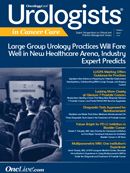Publication
Article
Oncology Live Urologists in Cancer Care®
How Can Group Practices Stay Current? LUGPA Counts the Ways
Author(s):
In a constantly changing and thus difficult-to-navigate healthcare world, thriving in community practice is nothing if not challenging.
OncLive Chairman,
Mike Hennessy
In a constantly changing and thus difficult-to-navigate healthcare world, thriving in community practice is nothing if not challenging.
ICD-10
Group practices in specialties like urology must grapple with myriad effects of the Affordable Care Act, including changed reimbursement practices, while planning ahead for the anticipated October 2015 implementation of the complicated and labor-intensive coding system. At the same time, the digital age increasingly demands that practices communicate with their patients through multiple avenues of social media.
How can practices give their patients the best care while also striving to stay current?
Once a year in Chicago, LUGPA, an organization of group urology practices, offers answers to that question in the form of its annual meeting. This past November, the meeting included workshops for practice and laboratory administrators, a continuing medical education program focused on biomarkers in prostate and bladder cancers, and reports about various LUGPA projects, including a study of the rate at which member urologists prescribe active surveillance to their eligible patients who have prostate cancer.
OncLive
was on site during the meeting to cover a variety of talks, which were designed to advise the group at large about how to deal successfully with some of the latest challenges involved in running a private practice. Our articles expound on where large group practices will excel in the new healthcare arena, how they can prepare for unannounced visits from government investigators, why it’s important for doctors to subspecialize and collaborate within groups, and what practices can do to maintain a strong presence online.
Also at the LUGPA meeting, we sat down with Samir Taneja, MD, of NYU Langone Medical Center, to ask about his institution’s experience in the use of multiparametric MRI in the diagnosis and treatment of prostate cancer. Since NYU Langone has been a pioneer in the use of this technique over the past two years, Taneja’s summary of that experience can be looked at as a model by others interested in implementing multiparametric MRI.
Elsewhere in this issue, we present a compilation of news items relevant to those who treat genitourinary cancers. Included is information about a gene discovered by researchers that not only helps to isolate Gleason Score 7 prostate cancer, but offers information regarding which Gleason 7 cancers are likely to become aggressive. We also explain the results of two studies that point to blood and body fats as drivers of prostate cancer, and describe a trial that demonstrated the effectiveness of a BRCA-targeted agent in the disease. And in the always intriguing world of immunotherapy, we discuss the promise of PD-L1 inhibitors in bladder cancer.
As a follow-up to our series on biomarkers in genitourinary cancers, we report on three diagnostic tests designed for use in the treatment of prostate cancer that are now reimbursable under Medicare.
Finally, to round out our look at issues important to group urology practices, we feature a profile of Premier Medical Group in Poughkeepsie, New York. In determining what its large group should comprise, the practice took the unusual step of merging with both a gastroenterology and an internal medicine practice, resulting in its ability to offer a wide array of medical services to its patients. The outcome may be of interest to other urology practices as they consider their own growth plans.
We hope that the information in these pages will be both interesting and instructive to our readers as they continue to build and strengthen their practices in the coming months.
As always, thank you for reading.










